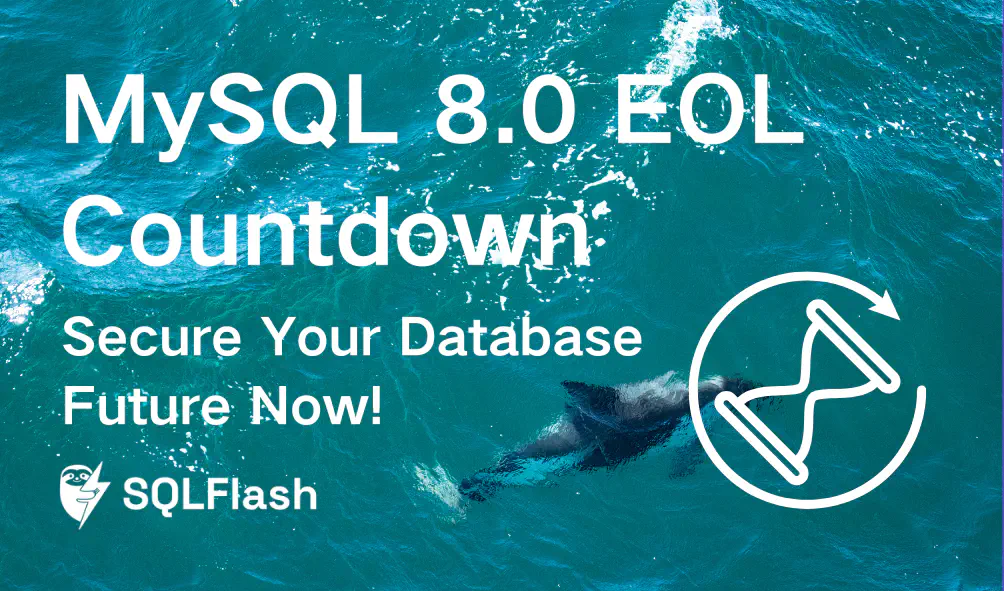MySQL 8.0 EOL Countdown: Secure Your Database Future Now!


MySQL 8.0 is approaching its End-of-Life (EOL) in April 2026, and database administrators (DBAs) must act now to avoid security vulnerabilities and compliance risks. This article helps DBAs navigate the impending MySQL 8.0 EOL by examining the upgrade, migration, and extended support options available.
MySQL 8.0 is a popular database that many businesses rely on. But like all software, it will eventually reach its End-of-Life (EOL). 💡 What does EOL mean? It means that Oracle, the company that makes MySQL, will stop providing updates, security fixes, and new features for version 8.0.
Think of EOL like this: Imagine your favorite toy breaks. If it’s still under warranty, the company will fix it. But once the warranty expires (EOL), they won’t fix it anymore. ⚠️ For databases, this is a big deal. Without security updates, your database becomes more vulnerable to attacks. Without bug fixes, problems can arise and disrupt your business. Also, using outdated software can violate rules about keeping data safe and private.
The EOL date for MySQL 8.0 is April 2026. While that might seem far away, it’s important to start planning now.
Migrating or upgrading a database is not like changing your phone. It’s more like moving your entire house! It takes time to:
If you wait until the last minute, you might rush the process and make mistakes. This can lead to downtime, lost data, or security problems. 🎯 Proactive planning ensures a smooth transition and minimizes risks.
As a DBA, you have a few main choices when MySQL 8.0 reaches EOL:
| Option | Description | Complexity | Potential Downtime |
|---|---|---|---|
| Upgrade | Move to a newer version of MySQL. | Medium | Moderate |
| Migrate | Switch to a different database system. | High | High |
| Extend | Use third-party support for continued updates. | Low | Low |
When MySQL 8.0 reaches its End-of-Life (EOL), you have choices. You can upgrade to a newer version, migrate to a different database, or extend support with a third-party. Let’s look at each option.
Upgrading means moving to a more recent version of MySQL. This is often the best option. You will likely upgrade to a later 8.x Long Term Support (LTS) release or potentially MySQL 9.x if it’s available.
Benefits of Upgrading:
Challenges of Upgrading:
Before upgrading your main (production) databases, always test the upgrade in a separate, identical test environment. This helps you find and fix any problems before they affect your users.
Migrating means moving your data to a completely different database. This is a bigger change than upgrading.
Why Migrate?
Possible Target Databases:
Challenges of Migrating: 🎯 This is the most complex option.
Some companies offer extended support for older software. This means they will provide security patches and bug fixes for MySQL 8.0 even after Oracle stops.
Benefits of Extended Support:
Drawbacks of Extended Support: ⚠️
Before choosing this option, carefully check the company’s reputation and what their support includes.
| Feature | Upgrade | Migrate | Extend Support |
|---|---|---|---|
| Complexity | Medium | High | Low |
| Cost | Medium | High | Medium |
| Security | High | High | Medium |
| Features | Latest | Depends on new database | Limited to MySQL 8.0 |
| Effort | Medium | High | Low |
Choosing the right strategy for your MySQL 8.0 End-of-Life (EOL) is important. Before you upgrade, migrate, or extend support, think about these key things.
Your applications need to work with your database. 🎯 Before doing anything, check if your applications will work with a newer MySQL version or a different database.
Here’s an example of things to test:
| Category | Examples |
|---|---|
| SQL Queries | SELECT statements, INSERT statements, UPDATE statements, DELETE statements |
| Stored Procedures | Calling stored procedures, checking return values |
| Functions | Using built-in functions, using custom functions |
| Data Types | Handling different data types (integers, strings, dates) |
Upgrading or migrating can change how fast your database works. ⚠️ Sometimes it gets faster, sometimes slower.
Here are some things to monitor:
| Metric | Description |
|---|---|
| Query Response Time | How long it takes for queries to run |
| CPU Usage | How much processing power the database is using |
| Memory Usage | How much memory the database is using |
| Disk I/O | How much the database is reading and writing to the disk |
Upgrading or migrating takes time, money, and people. Plan carefully!
Here’s a table to help you estimate resources:
| Resource | Considerations |
|---|---|
| Time | Planning, testing, migration process, rollback (if needed) |
| Budget | Software licenses, hardware costs, personnel costs, consulting fees |
| Personnel | DBAs, developers, project managers |
| Infrastructure | Servers, storage, network bandwidth |
| Downtime | Impact on business operations, communication plan, rollback procedure |
SQLFlash is your AI-powered SQL Optimization Partner.
Based on AI models, we accurately identify SQL performance bottlenecks and optimize query performance, freeing you from the cumbersome SQL tuning process so you can fully focus on developing and implementing business logic.
Join us and experience the power of SQLFlash today!.